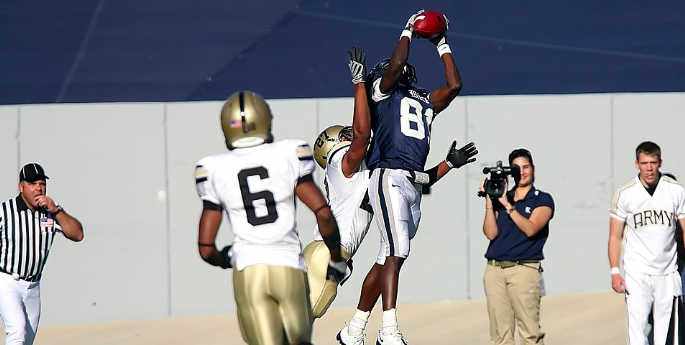With all the different terminology in football, it can be tough to keep up. One football term which often leaves football fans confused is flanker.
A flanker in football is an outside receiver that lines up across the field from the #1 receiver. Flankers are not usually the main target of an offense and are often tasked with being the second or third option on passing plays.
The flanker position can be a tough term to define because it originated a long time ago. As the game evolved the term came with it yet the definition was never made official.
Some sites state that for a receiver to be a flanker they need to start the play off of the line of scrimmage.
This is often the case with the flanker when he lines up on the same side as the tight end. Since the tight end, the five linemen, and the number one receiver are on the line that makes up seven.
Only seven players will be on the line of scrimmage each play. This means the flanker will often be off the line but it is not necessarily the case. If there is no tight end or they are off the line of scrimmage the flanker will usually line up on the line of scrimmage.
Key Responsibilities Of The Flanker Position
Now that you know what a flanker is in football it is time to break down what this position does. Below we will cover the main responsibilities this position has on the field.
Pass Catching

Flankers are not going to be the number one receiving option on their team but they still should see a fair number of passes head their way.
The flanker often acts as the second option on the offense. If the number one receiver is getting a lot of defensive attention it is not uncommon for the offense to pass more to the second receiver.
Throughout a full season, a flanker should receive a fairly large number of targets and yards.
Run Blocking On Outside Runs
Though receivers of any kind are not usually known for their run blocking flankers will have to help out on outside runs.
If a run is going towards the sideline the flanker plays on he is going to have to block his man. Receivers are usually larger than cornerbacks meaning they are often able to block them effectively.
Crossing Routes And Clear Outs

Since this position is not typically the main option on an offense these players are often tasked with helping out the other receivers.
This often means running pick plays or clearouts. Pick plays in the receivers running routes very close to one another in hopes of getting in the way of the defenders.
A clear-out route involves one receiver like a flanker running deep in order to open up an area for another receiver.
Flankers will play these roles a few times a game in order to create more room for the other receivers.
Where Did The Name Come From?
The name for the flanker position has been around for a long time in football. When the term flanker first came about there was only a single wide receiver on the football field.
As the game progressed and added another receiver this player was referred to as a flanker. The name flanker was given because the receiver lines up on the other side of the field.
This way the second receiver would be flanking the opponent as they were used to preparing to stop only a single receiver.
Split ends vs flankers
One term often heard when talking about flankers is split ends. This terminology of split end is usually used when describing the other receiver on the field aside from the flanker.
A split end is a wide receiver who lines up on the line of scrimmage near the sideline. Generally speaking, the flanker position is going to line up off the line of scrimmage.
The flanker is generally going to be on the same side of the field as the tight end. This is because the flanker being off the line of scrimmage is going to allow the tight end to be an eligible receiver.
The outermost player on the line of scrimmage is going to be the only player on the line of scrimmage who is eligible to catch passes.
This is why tight ends who line up on the line of scrimmage are usually on the same side of the field as the flanker who stays off the line.

